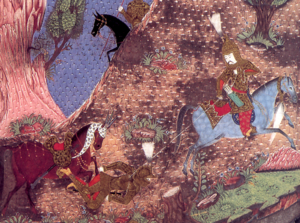
Back معركة قوصوه الثانية Arabic معركة قوصوه التانيه ARZ Kosovo döyüşü (1448) Azerbaijani Косовска битка (1448) Bulgarian Druhá bitva na Kosově poli Czech Schlacht auf dem Amselfeld (1448) German Μάχη του Κοσσυφοπεδίου (1448) Greek Segunda Batalla de Kosovo Spanish Kosovo lahing (1448) Estonian Bataille de Kosovo (1448) French
| Second Battle of Kosovo | |||||||
|---|---|---|---|---|---|---|---|
| Part of the Ottoman wars in Europe and Ottoman-Hungarian Wars and Ottoman-Wallachian wars | |||||||
 An akinji defeating a Hungarian knight with a lasso. | |||||||
| |||||||
| Belligerents | |||||||
|
Ottoman Empire Karamanids[1] |
Kingdom of Hungary | ||||||
| Commanders and leaders | |||||||
|
Murad II Prince Mehmed |
John Hunyadi Franko Talovec † Michael Szilágyi | ||||||
| Strength | |||||||
| 50,000–60,000[8][9] | 31,000–47,000 (7,000 cavalry , 24,000–40,000 infantry)[10] | ||||||
| Casualties and losses | |||||||
| 4,000–34,000[11][12][b] | 6,000–17,000[11][12][b] 17,000 (9,000 Hungarians, 2,000 Mercenaries, 6,000 Wallachians)[5] | ||||||
The Second Battle of Kosovo (Hungarian: második rigómezei csata, Turkish: İkinci Kosova Muharebesi) was a land battle between a Hungarian-led Crusader army and the Ottoman Empire at Kosovo field that took place from 17–20 October 1448. It was the culmination of a Hungarian offensive to avenge the defeat at the Battle of Varna four years earlier. In the three-day battle the Ottoman army under the command of Sultan Murad II defeated the Crusader army of regent John Hunyadi.
After the battle, the path was clear for the Turks to conquer Serbia and the other Balkan States, it also ended any hopes of saving Constantinople. The Hungarian kingdom no longer had the military and financial resources to mount an offensive against the Ottomans. With the end of the half-century-long Crusader threat to their European frontier, Murad's son Mehmed II was free to lay siege to Constantinople in 1453.
- ^ Koçu, Reşad Ekrem. Fatih Sultan Mehmed. p. 39.
- ^ Osmanlı Devleti'nin Kuruluş Tarihi (1299–1481) Müneccimbaşı Ahmed B. Lütfullah
- ^ Bury, p. 1814.
- ^ Treadgold 1997, p. 797.
- ^ a b Bánlaky, József. "A rigómezei csata 1448 október 17-től 19-ig" [The Battle of Kosovo at 17–19 October in 1448]. A magyar nemzet hadtörténelme [The Military History of the Hungarian Nation] (in Hungarian). Budapest.
- ^ Mesut Uyar Ph.D., Edward J. Erickson (2009). A Military History of the Ottomans: From Osman to Ataturk (PDF). Archived (PDF) from the original on 2021-02-27. Retrieved 2022-04-08.
- ^ Chalkokondyles, Laonikos (1464). The Histories of Laonikos Chalkokondyldes, Volume I (Translated by Anthony Kaldellis, 2014).
- ^ Mufassal Osmanlı Tarihi 1.cilt Mustafa Cezar
- ^ Babinger, Franz. Fatih Sultan Mehmed ve Zamanı. Alfa Yayınevi. p. 98.
- ^ Babinger, Franz. Fatih Sultan Mehmed ve Zamanı. Alfa Yayınevi. p. 96.
- ^ a b Antoche 2017, p. 273.
- ^ a b Babinger, Manheim & Hickman 1978, p. 55.
Cite error: There are <ref group=lower-alpha> tags or {{efn}} templates on this page, but the references will not show without a {{reflist|group=lower-alpha}} template or {{notelist}} template (see the help page).